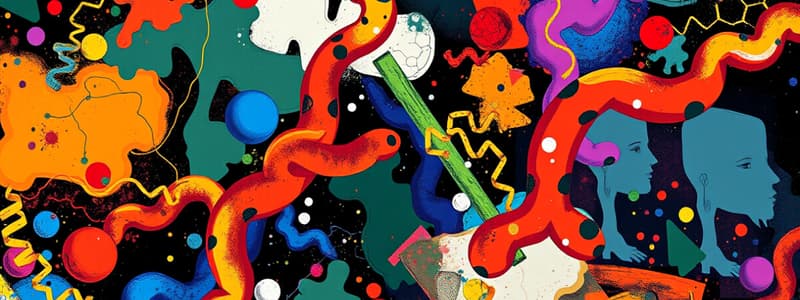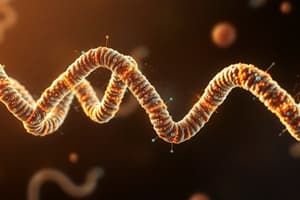Podcast
Questions and Answers
What is a peptide bond?
What is a peptide bond?
A peptide bond forms between the carboxylic acid of one amino acid and the amino group of the next amino acid with the loss of H2O.
How does the primary structure of proteins differ from the secondary structure?
How does the primary structure of proteins differ from the secondary structure?
Primary structure involves the peptide bonds that join one amino acid to the next, while secondary structure includes alpha helix and beta pleated sheet formations.
Define protein.
Define protein.
Composed of molecular building blocks called amino acids, if more than 50 amino acids are in the peptide chain with biological activity, it is a protein.
Identify major roles of proteins in the body.
Identify major roles of proteins in the body.
What is protein shape and bonding at the primary level?
What is protein shape and bonding at the primary level?
What is protein shape and bonding at the secondary level?
What is protein shape and bonding at the secondary level?
What is protein shape and bonding at the tertiary level?
What is protein shape and bonding at the tertiary level?
What is protein shape and bonding at the quaternary level?
What is protein shape and bonding at the quaternary level?
Describe denaturation effects caused by temperature.
Describe denaturation effects caused by temperature.
Describe denaturation effects caused by pH.
Describe denaturation effects caused by pH.
Describe denaturation effects caused by heavy metals.
Describe denaturation effects caused by heavy metals.
Describe denaturation effects caused by organic molecules.
Describe denaturation effects caused by organic molecules.
What are the color changes associated with positive and negative tests of the Biuret test?
What are the color changes associated with positive and negative tests of the Biuret test?
What are the color changes associated with positive and negative tests of the Ninhydrin test?
What are the color changes associated with positive and negative tests of the Ninhydrin test?
What are the color changes associated with positive and negative tests of the Xanthoproteic test?
What are the color changes associated with positive and negative tests of the Xanthoproteic test?
Why are heat and alcohol used to disinfect medical equipment?
Why are heat and alcohol used to disinfect medical equipment?
Why is milk given to someone who accidentally ingests a heavy metal ion?
Why is milk given to someone who accidentally ingests a heavy metal ion?
How does a change in pH affect the structural levels of a protein?
How does a change in pH affect the structural levels of a protein?
What might be the reason for a yellow spot on a student's hand after working with HNO3?
What might be the reason for a yellow spot on a student's hand after working with HNO3?
Which samples gave a negative Biuret test and why?
Which samples gave a negative Biuret test and why?
What functional group gives a positive test in the xanthoproteic test?
What functional group gives a positive test in the xanthoproteic test?
What tests could you use to determine whether an unlabeled test tube contained an amino acid or a protein?
What tests could you use to determine whether an unlabeled test tube contained an amino acid or a protein?
Flashcards
Peptide Bond
Peptide Bond
The bond formed between the carboxyl group of one amino acid and the amino group of another, releasing water.
Primary Structure (Protein)
Primary Structure (Protein)
The sequence of amino acids in a protein, linked by peptide bonds.
Secondary Structure (Protein)
Secondary Structure (Protein)
Local folded structures in a protein, like alpha helices and beta-pleated sheets.
Tertiary Structure (Protein)
Tertiary Structure (Protein)
Signup and view all the flashcards
Quaternary Structure (Protein)
Quaternary Structure (Protein)
Signup and view all the flashcards
Protein
Protein
Signup and view all the flashcards
Protein Function
Protein Function
Signup and view all the flashcards
Biuret Test
Biuret Test
Signup and view all the flashcards
Biuret Test (Negative)
Biuret Test (Negative)
Signup and view all the flashcards
Ninhydrin Test
Ninhydrin Test
Signup and view all the flashcards
Xanthoproteic Test
Xanthoproteic Test
Signup and view all the flashcards
Protein Denaturation
Protein Denaturation
Signup and view all the flashcards
Disinfection (Protein)
Disinfection (Protein)
Signup and view all the flashcards
Milk as a Buffer
Milk as a Buffer
Signup and view all the flashcards
pH changes and proteins
pH changes and proteins
Signup and view all the flashcards
Xanthoproteic Test reaction (skin)
Xanthoproteic Test reaction (skin)
Signup and view all the flashcards
Study Notes
Peptide Bonds
- A peptide bond forms between the carboxylic acid of one amino acid and the amino group of another, releasing water (H2O).
Structure of Proteins
- Primary structure: Sequence of amino acids linked by peptide bonds.
- Secondary structure: Includes alpha helices (coiled peptide chains) and beta-pleated sheets (formed between protein strands).
- Tertiary structure: 3D shape due to interactions between side groups (ionic bonds, disulfide bonds, hydrophilic interactions).
- Quaternary structure: Combination of two or more tertiary structures or polypeptide chains.
Definition of Proteins
- Composed of amino acids; a molecule is categorized as a protein if it contains more than 50 amino acids with biological activity.
Functions of Proteins
- Essential for the structure of skin, muscle, cartilage, hair, fingernails, enzymes, and hormones.
Protein Bonding
- Primary: Linking through peptide bonds, forming dipeptides, tripeptides, etc.
- Secondary: Stabilized by hydrogen bonding; alpha helix resembles a spiral staircase, while beta pleated sheets resemble folding or pleating.
Denaturation of Proteins
- Temperature: Breaks hydrogen bonds and disrupts hydrophobic interactions.
- pH: Affects hydrogen bonds and salt bridges.
- Heavy metals: Disrupt disulfide bonds through ionic bond formation.
- Organic molecules: Disrupt hydrophobic interactions.
Biuret Test
- Positive test indicates presence of peptide bonds; the solution changes from blue (Cu²⁺) to violet for proteins with two or more peptide bonds.
- Negative reaction remains blue, showing only individual amino acids or dipeptides.
Ninhydrin Test
- Used to detect amino acids in proteins; most amino acids yield a blue-violet color, while proline and hydroxyproline result in a yellow color.
Xanthoproteic Test
- Detects amino acids with aromatic rings; concentrated nitric acid produces yellow-colored nitro-substituted products from tyrosine and tryptophan.
Disinfection Methods
- Heat and alcohol disinfect by denaturing proteins, destabilizing secondary, tertiary, and quaternary structures.
Milk and Heavy Metal Ingestion
- Milk acts as a buffer by reacting with heavy metal ions like silver or mercury, protecting the body from toxicity.
pH Changes and Protein Structure
- Alterations in pH disrupt bonds maintaining tertiary structures.
Xanthoproteic Test Reaction
- The yellow spot on skin after nitric acid exposure indicates oxidization leading to the formation of a yellow product.
Negative Biuret Test
- Glycine and tyrosine yield negative results due to lacking multiple peptide bonds; biuret test requires the presence of those bonds for a positive outcome.
Functional Group in Xanthoproteic Test
- The presence of an aromatic ring confirms a positive reaction in the xanthoproteic test.
Differentiating Amino Acids and Proteins
- The biuret test can distinguish between amino acids and proteins in an unlabeled test tube.
Studying That Suits You
Use AI to generate personalized quizzes and flashcards to suit your learning preferences.




